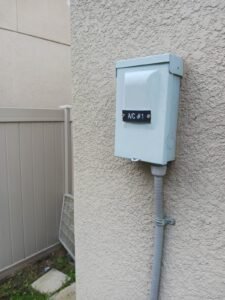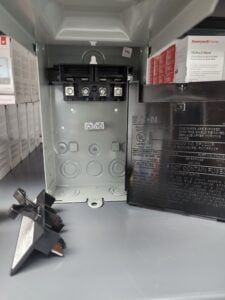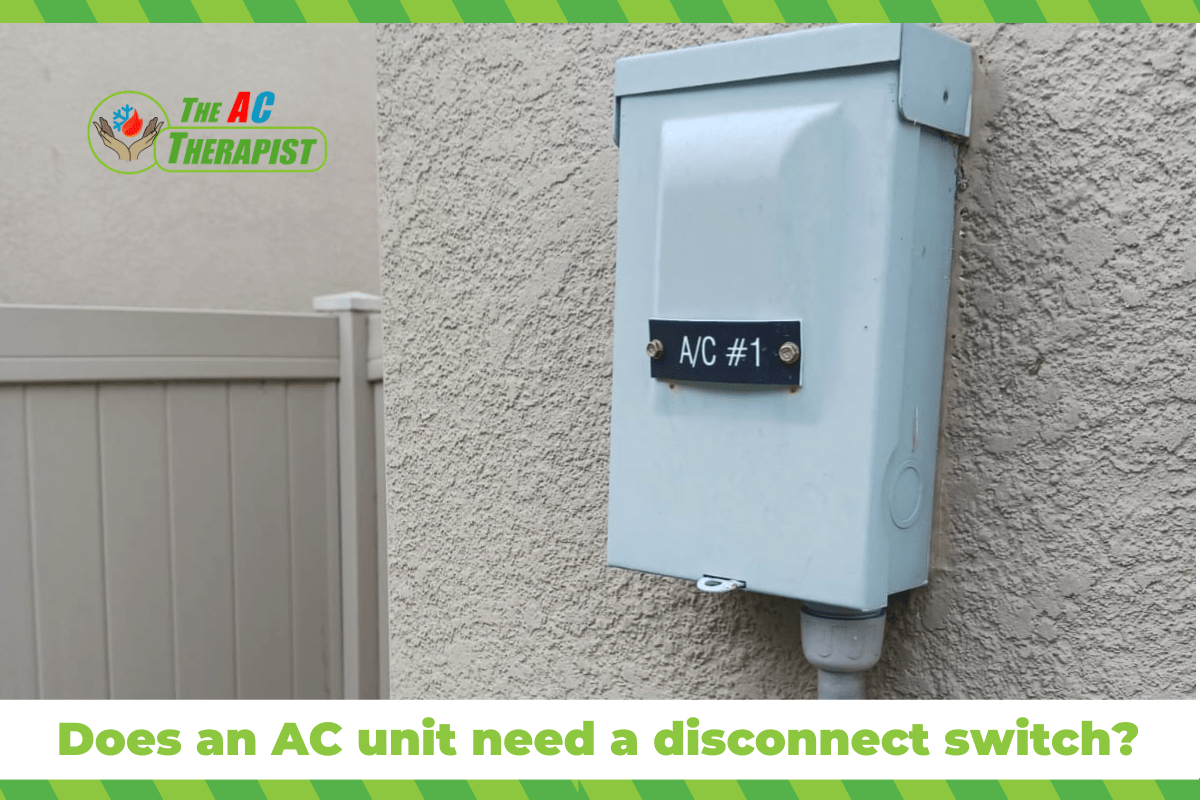Does an AC unit need a disconnect switch?
As a premier HVAC contractor operating in the Tampa Bay area, we at The AC Therapist often get a plethora of queries related to air conditioning units. One question that seems to come up regularly is: does an AC unit need a disconnect switch? In this comprehensive guide, we will explain what a disconnect switch is, why it is necessary for an air conditioning unit, and the regulations surrounding its use.
To start with, a disconnect switch is a safety feature installed alongside an AC unit, designed to interrupt the power supply swiftly and completely. This is incredibly vital in emergency situations and for routine maintenance purposes.
Understanding the Disconnect Switch
A disconnect switch, sometimes referred to as a pull-out switch or a shutoff switch, is a device that is used to ensure the electrical circuit to your AC unit can be easily and completely interrupted. The primary reason for having such a device is safety. During an emergency, a quick and easy way to turn off the AC unit may become paramount, and this is where a disconnect switch becomes crucial. It also allows for secure power isolation during routine maintenance or repair work on your unit.

Why an AC Unit Needs a Disconnect Switch
There are two significant reasons why an AC unit requires a disconnect switch:
- Safety: Electricity can be a dangerous thing, especially when it comes to maintenance or repair. Working on an AC unit without first disconnecting it from its power source can result in severe injury or even death due to electrocution. The disconnect switch allows a technician or homeowner to quickly cut off the power to the unit without having to navigate through the circuit breaker box, ensuring the AC unit is safe to work on.
- Legal Requirements: In most places, having a disconnect switch for your AC unit is not just a recommendation; it is a legal requirement. The National Electrical Code (NEC) states that all fixed appliances, which includes air conditioning units, must have a disconnecting means within sight from the equipment and from the location at which the conductor or conductors enter a building or structure. In other words, your AC unit’s disconnect switch must be easily accessible and within a line of sight from your unit.
The Regulations Surrounding Disconnect Switches
The regulations surrounding disconnect switches for air conditioning units are critical to ensuring the safety and well-being of building occupants, as well as the effective operation of the HVAC systems themselves. In the United States, the National Electrical Code (NEC) provides the primary set of standards for the installation of disconnect switches.
Here are the key regulations:
1. Placement and Accessibility
According to NEC, the disconnect switch must be located within sight of and readily accessible from the air conditioning unit it serves. “Within sight” is defined as visible and not more than 6 feet from the unit. “Readily accessible” means the disconnect switch can be reached quickly and easily, without needing to move any obstacles, climb over anything, or use a tool or key to gain access.
2. Lockable Disconnects
If the disconnect can’t be located within sight due to structural constraints, the NEC permits the use of lockable disconnect switches that can be locked in the off position, so unauthorized personnel can’t reactivate the power supply during maintenance or an emergency.
3. Disconnect Rating
The disconnect switch must have an appropriate rating for the unit it serves. It needs to be capable of carrying and breaking the current under both normal and abnormal conditions, such as short circuits or overload situations. The disconnect switch must be rated adequately to handle the maximum current that the AC unit can draw.
4. Types of Disconnects
The type of disconnect switch to be used often depends on the specific characteristics of the AC unit. For an AC unit with built-in overcurrent protection, a non-fusible disconnect switch would typically be used. On the other hand, older AC units without built-in overcurrent protection might require a fusible disconnect switch to add an additional layer of safety.
Compliance with these regulations is not just a matter of legality, it is essential for the safety of building occupants and for the longevity and proper operation of the AC system. As professionals, we at The AC Therapist are well-versed in these regulations and always ensure that our installations are compliant with the NEC for the safety and satisfaction of our clients.

Types of Disconnect Switches
Disconnect switches come in a variety of styles and types, each designed to meet certain needs and circumstances. However, the two main types of disconnect switches used for AC units are non-fusible and fusible disconnect switches.
1. Non-Fusible Disconnect Switches
Non-fusible disconnect switches function essentially as on-off switches. They do not include any fusing or overcurrent protection. If a current overload occurs, a non-fusible disconnect switch will not be able to break the circuit. However, it is worth noting that most modern AC units have built-in overcurrent protection mechanisms. In such cases, a non-fusible disconnect switch is typically sufficient.
Non-fusible disconnect switches are generally simpler in design and cheaper than their fusible counterparts. They are commonly used in residential AC installations due to their ease of operation.
2. Fusible Disconnect Switches
Fusible disconnect switches incorporate fuses into their design. These fuses are designed to blow, or fail, when an overcurrent situation occurs, thereby disconnecting the power supply. This adds an extra layer of protection against electrical fires and damage to the equipment.
Fusible disconnect switches are generally used in situations where there is a higher risk of overcurrent, or where the AC unit itself does not have built-in overcurrent protection. This is often the case in older AC units or certain commercial installations. However, they are usually more expensive and complex to replace than non-fusible disconnect switches.
Each type of disconnect switch serves an essential role in ensuring the safe operation of your AC unit. While non-fusible disconnect switches are commonly used due to their simplicity and cost-effectiveness, fusible disconnect switches can offer an extra layer of protection in certain situations.
Remember, if you’re unsure about the type of disconnect switch suitable for your AC unit, it’s best to consult with a professional HVAC contractor. If you’re in the Tampa Bay area, The AC Therapist team is always ready to assist with your HVAC needs.

Installing a Disconnect Switch
A disconnect switch should be installed by a licensed professional due to the risks associated with handling electrical wiring. Incorrect installation can lead to malfunctioning of the AC unit, electrical fires, or in severe cases, electrocution. We, at The AC Therapist, highly recommend hiring a professional HVAC contractor to ensure the safe and proper installation of a disconnect switch.
7 steps to install a disconnect switch:
While it’s important to note that the installation of a disconnect switch is best performed by a licensed professional due to the inherent dangers associated with working with electricity, here are the basic steps that a professional might take:
Step 1: Select a Suitable Location Choose an accessible, visible location no more than 6 feet away from the AC unit to place the disconnect switch. It’s essential to follow the ‘within sight’ rule from the National Electrical Code (NEC).
Step 2: Turn Off the Power Before starting any work, make sure to turn off the power from the main circuit breaker to ensure safety.
Step 3: Install the Disconnect Box Secure the disconnect box to the wall at a convenient height, typically chest high. Ensure the box is level for proper installation.
Step 4: Route the Wiring Route the wires from the circuit breaker and the AC unit to the disconnect box. This usually involves drilling a hole in the wall of your house, passing the cable through, and sealing the hole.
Step 5: Connect the Wires Inside the box, connect the wires from the circuit breaker to the line terminals and the wires from the AC to the load terminals. Make sure the grounding wire is properly connected as well.
Step 6: Install the Disconnect In a pull-out style disconnect box, insert the disconnect block and pull it out to ensure it is functioning correctly.
Step 7: Test the Installation Turn on the power from the main circuit breaker and test the disconnect switch by turning the AC unit on and off.
Remember, working with electricity can be dangerous, and it’s always recommended to let a professional handle these types of installations. You don’t want to risk causing damage or personal injury. If you’re in the Tampa Bay area, don’t hesitate to reach out to us at The AC Therapist for professional HVAC services.
How do I know if my AC disconnect is on or off?
Understanding the state of your air conditioner’s disconnect switch is a key aspect of maintaining safety during its operation. However, the methods to identify whether the disconnect switch is on or off can vary, primarily depending on the type of disconnect switch installed.
1. Pull-out Style Disconnect Switch
This is a common type of disconnect switch used with residential air conditioning units. To determine if the switch is on or off:
- Off State: If the disconnect switch is a pull-out type and the block is removed or pulled out, then the switch is in the off position. This means that the electrical supply to the AC unit is disconnected.
- On State: If the block is fully inserted into the disconnect box, then the switch is in the on position, and the AC unit is connected to its power source. Sometimes it can be inserted in reverse and thus it will not work.
2. Circuit Breaker Style Disconnect Switch
This type of switch looks and operates much like a typical circuit breaker found in the electrical panel.
- Off State: If the switch is in the middle or ‘tripped’ position or fully to the right or ‘off’ position, the AC unit is disconnected from its power source.
- On State: If the switch lever is fully to the left or ‘on’ position, the AC unit is connected to its power source.
Remember, if you are unsure or uncomfortable identifying the state of your disconnect switch, it’s always safe and recommended to consult with a professional HVAC contractor. The AC Therapist team in the Tampa Bay area is always ready to assist with your air conditioning needs.

How much does it cost to install a disconnect switch on my AC?
The cost of installing a disconnect switch for your AC unit can vary based on a number of factors, including the type of switch required (non-fusible or fusible), the cost of the switch itself, and the cost of labor in your local area.
Generally, the cost of the disconnect switch itself can range from $15 to $60, depending on the type and brand of the switch.
The cost of labor will vary based on local rates and the complexity of the installation. On average, a licensed electrician or HVAC professional might charge anywhere from $180 and $250 flat rate to install it.
Therefore, you could expect the total cost for the installation of a disconnect switch to range roughly from $180 to $280. Please note that these are ballpark figures and the actual costs could be higher or lower based on the specific circumstances of your installation.
It’s always best to get a quote from a local professional to understand the exact cost in your area. If you’re in the Tampa Bay area, The AC Therapist would be happy to provide a quote for this service.
Should you install a surge protector on your AC’s disconnect switch?
Installing a surge protector on your air conditioning unit’s disconnect switch can be a smart move, as it provides an extra layer of protection for your HVAC system. Surge protectors help to shield your system from sudden spikes in voltage, which can occur due to power outages, lightning strikes, or other unforeseen electrical disturbances.
These voltage surges can potentially damage sensitive electrical components within your air conditioner, resulting in costly repairs or even requiring a full system replacement. By installing a surge protector, you can help mitigate this risk.
Here’s how it works: The surge protector is designed to divert any excess voltage safely to the ground, preventing it from reaching your air conditioner. When a voltage spike occurs, the surge protector quickly reacts, diverting the excess voltage and thereby protecting your AC unit from harm.
Installation of a surge protector should be done by a qualified professional, as it involves working with high voltage electrical systems. Keep in mind that while a surge protector can provide an additional level of protection, it does not replace the need for a disconnect switch, which provides a way to quickly disconnect the power supply to the AC unit for safety or maintenance purposes.
So, if you live in an area with frequent power outages or electrical storms, or if you simply want to take every precaution to protect your investment in your AC system, a surge protector could be a good addition. As always, if you’re in the Tampa Bay area, The AC Therapist team would be happy to help evaluate your needs and provide professional installation services.
Do I need a disconnect switch on for the Air Handler (inside unit)?
Yes, according to the National Electrical Code (NEC), a disconnecting means is required for all appliances, which includes air handlers. The disconnect switch provides a means to disconnect the power supply for servicing, maintenance, or during an emergency situation, ensuring the safety of service technicians and building occupants.
The disconnect for an air handler can be a separate disconnect switch installed near the unit, or it could be a circuit breaker in the electrical panel, provided it is clearly marked and readily accessible within 6 feet.
Remember, for safety and compliance with these regulations, the installation of a disconnect switch should be carried out by a licensed professional. At The AC Therapist, we have the experience and knowledge to ensure your air handler is installed correctly and safely, in accordance with all relevant regulations.
Key Takeaways: The Importance of AC Disconnect Switches for Safety and Compliance
In conclusion, the installation of a disconnect switch for your air conditioning unit is not just a regulatory requirement but also a key safety measure. These switches provide an essential means to disconnect the power supply to the AC unit for maintenance, repairs, or during an emergency, ensuring the safety of technicians and building occupants.
Whether you opt for a non-fusible or a fusible disconnect switch will largely depend on your specific circumstances and the characteristics of your AC unit. Non-fusible disconnect switches are commonly used due to their simplicity and cost-effectiveness. However, fusible disconnect switches can provide an extra layer of protection against overcurrent situations.
The National Electrical Code mandates specific placement and accessibility requirements for disconnect switches. The disconnect switch must be within sight and readily accessible from the AC unit it serves. In situations where this can’t be achieved due to structural constraints, lockable disconnect switches that can be locked in the off position are permissible.
An additional surge protector can also be considered for an added layer of protection against electrical surges, which can potentially damage your AC unit. However, the installation of both disconnect switches and surge protectors should be carried out by a licensed professional to ensure safety and compliance with all regulations.
The AC Therapist team in the Tampa Bay area prides itself on providing professional, reliable, and regulation-compliant HVAC services. From AC installation and repair to comprehensive maintenance services, we ensure every aspect of your HVAC system meets safety standards and serves your cooling needs effectively. Contact us today for assistance with all your HVAC needs.








